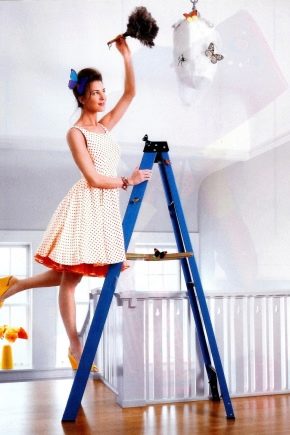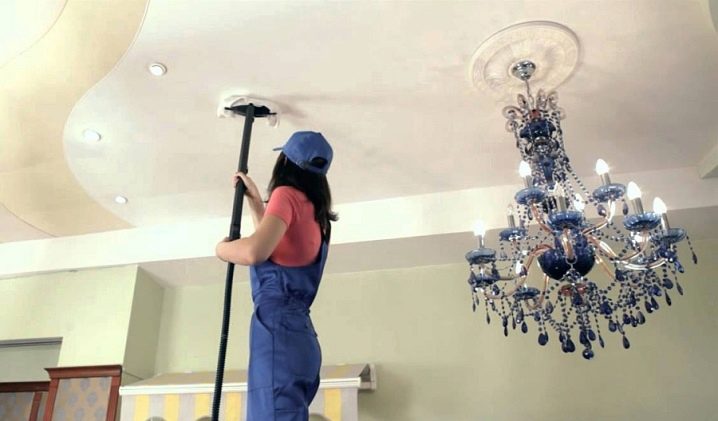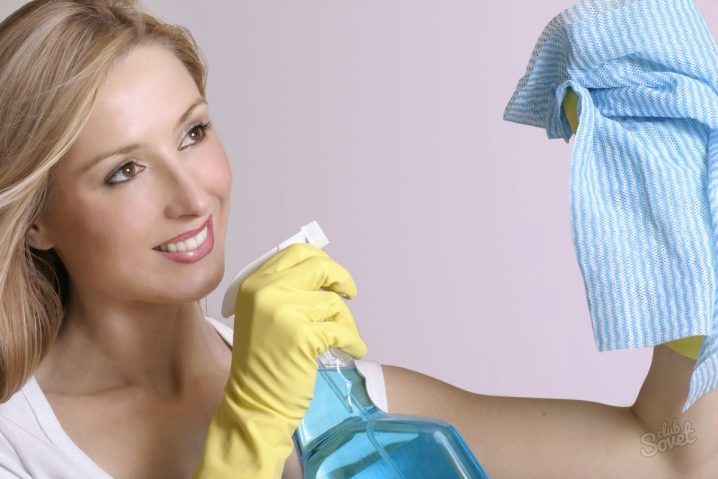How to clean stretch ceilings?

Stretch ceilings in the interior are one of the most beautiful details of a room's decoration. But in reality, this beauty is just a cloth or film stretched over slats. It is treated with special solutions and can resist dirt and dust.
Glossy surfaces shine, reflecting the interior and its furniture. But like any object in the room, the stretch ceiling begins to collect dust and can become stained. And sooner or later the moment will come when the canvas will have to be cleaned and washed. You will learn how to do this in this article.

Peculiarities
It is very difficult to clean a stretch ceiling, so this process should be done with the utmost care and preparation.
One of the problems is the awkward posture in which you have to work. Constantly holding your arms up can cause numbness in your arms and legs. A stepladder is not suitable for this, since it is easy to fall from it, injure yourself and, if it falls, damage the ceiling. Therefore, care must be taken to ensure that the structure on which the person will stand is stable. And even if you have to deal with the ceiling with both hands, legs should be supported without the slightest hint of swaying... Therefore, to clean the stretch ceiling, it is worthwhile to provide a special step-ladder or piece of furniture at home, which will allow you to calmly clean the surface.
Before starting the process, you need to prepare yourself. Cutting and piercing jewelry must be removed, since the canvas is very delicate and you can accidentally damage the fabric or film. All rings and chains must be set aside until the end of cleaning.

Even long nails can cause scratches that will ruin the finish. Therefore, housewives with a manicure must necessarily work with gloves.
What can you use?
To work with the canvas, it is worth picking up soft, clean rags. Old bedding and baby diapers that need to be torn into small pieces are fine. You also need to stock up on new soft sponges, a vacuum cleaner and non-abrasive detergents. In order to keep the stretch ceiling in all its glory as long as possible, you need to handle it gently, gently and effortlessly.
Stretch ceilings are made of films and fabrics, so they need to be handled delicately. If the ceiling is dusty, you can use plain water and a soft cloth. If the dirt becomes more noticeable and water does not help, it becomes necessary to use detergents.

Funds
Of the wet cleaning products that are offered on the market, it is better to choose the most forgiving. This is Vanish, Mr. Proper and Mister Muscle. They cannot be used in concentrated form.... Household chemicals must be diluted with water and the ceiling surface must be washed. Then the condition of the fabric will return to its original form, and stains will not remain on the ceiling.
There are also special products for use on stretch ceilings. The polish intended for this will return the shine and beauty to the canvas. Before using it, you must carefully read the instructions for use, and only then work with the ceiling.
Also it is worth paying attention to the anti-static ceiling care productsm. This will allow not only to remove dust in a timely manner, but also to prevent it from getting to the surface.Thanks to the antistatic effect, dust particles will be repelled from the ceiling, cleaning will become less frequent and will be much easier.



If you don't have special household chemicals at hand, you can use mild household detergents with a small amount of alkali.
Laundry or baby soap is suitable for cleaning the ceiling. But it should only be used as a foam. You cannot soap the ceiling by applying soap directly to the canvas.... It is necessary to make foam from it, and already wash the surface with it. It will eat away dirt, dust, stains and can be easily removed with water.
It is important to take water for cleaning the ceiling with a temperature of 37-38 degrees... Some fabrics can tolerate higher degrees, but experimenting is not worth it. 40 degrees is the maximum temperature for cleaning the ceiling fabric.
You can also use a window cleaner containing ammonia for cleaning. It should not contain acetone, you can read about it in the instructions. Household chemicals are best suited in the form of a spray, which must be sprayed. The less pressure you put on the web, the better.... So the fabric or film will remain intact for longer.



After using detergents, especially soaps, streaks may remain. To do this, the ceiling must be washed several times with warm clean water and a sponge. After each wash, the sponge is washed and the water is replaced with a new one. After washing, wipe dry with a clean clothth. After wiping, there should be no marks or streaks.
A 1:10 solution of high-quality alcohol will help to recreate the shine on a glossy canvas. Most often, ammonia is used for this. It does not clean dirt very well, but it does not harm the fabric.

For cleaning, you can use a steam generator, a steam cleaner or carefully apply a karcher.
Forbidden to use
For wet cleaning of ceilings, it is forbidden to use soda ash and baking soda, washing powders, Antipyatin soap, detergents with acids, concentrated alkalis, chlorine, abrasive powders, as they will damage the ceiling surface.
Creamy detergents, which may contain abrasive particles, are also prohibited. All of them have a destructive effect on the canvas. The colors lose their brightness, the shine of the fabric disappears. Microcracks form in the canvas, wrinkles and scratches appear externally. In the end, sagging and even holes can form, so strongly the products listed above negatively affect the fabric and film. As a result, after aggressive washing, all beauty will be lost, and the ceiling will have to be redone. Therefore, it is necessary to follow the rules for choosing detergents in order to preserve the beauty of the ceiling and the entire interior as long as possible.

If there is any doubt about how much household chemicals can affect the fabric, it is necessary to apply it to a small inconspicuous piece of canvas, and only after making sure that there is no danger to it, you can use the product on the entire surface.
How to clean?
Stretch ceilings by material composition are of two types - fabric and PVC. They differ in appearance and some of the nuances of cleaning.
The fabric for such ceilings is made of synthetic thread, which is then additionally impregnated. This is a wicker canvas, which looks like a well-plastered wall, sometimes with embossing, imitation of suede and satin, with hand painting. Fabric cloth - only matte, since it is impossible to achieve gloss on it, although designers note that mattness in the interior sometimes looks even more aristocratic than glossy sheen. Due to the large width of the fabric, such a ceiling can be made as a single panel for a room without seams.
PVC material - these are films that differ in density and uniformity, as they are made on special production machines. They are homogeneous in appearance, they are matte, glossy and satin.Matte films look like a whitewashed ceiling, glossy films reflect the surrounding interior and light, visually expanding the room, satin ones create a blurry soft reflection. Films have a wider variety of shades up to metallic; they can be produced with photo printing of any patterns. Their coating can be varnish, mirror, translucent, like tinted glass, light-transmitting, mother-of-pearl and perforated.


Stretch ceilings create a beautiful interior not only in the rooms. They can be used in the kitchen, bathroom and even in the loggia. But in these rooms, more attention is needed to the canvases, since they are susceptible to active pollution from the environment.


Nicotine
Modern materials used for the manufacture of stretch ceilings are quite dense and are treated with antistatic and dirt-repellent materials. As a result, dust particles practically do not adhere to the coating. Therefore, it is possible to smoke indoors, although it is not recommended to do so in order not to cause a fire.
In general, nicotine should not settle on the coating. If, after a long time, the ceiling is still contaminated with traces of nicotine, it is removed in the same way as other simple contamination. Dry cleaning, water, the usual products for such ceilings are able to remove dirt... No special measures are required to clean up nicotine traces.

Dust
Modern canvases on stretch ceilings are treated with special means so that dust does not cling to them. Therefore, dust particles do not adhere well to ceiling fabrics and films. If you periodically dust the ceiling with a damp or dry cloth, you can keep it in good condition.
You can vacuum up the dust from the ceiling. But even the softest brushes can damage the fabric or loosen the tension. Therefore, when collecting dust, it is necessary to keep the vacuum cleaner brush at a distance of a couple of centimeters from the canvas.

Stains
It is more difficult if a speck of, for example, glue appears on the canvas. When the entire surface is clean, you can start removing the stain. If the entire ceiling is already dusty, the rubbed stain will look like a light area against the background of the rest of the dark surface and spoil the whole look. In this case, it is necessary to start cleaning the entire ceiling.
In the bathroom, lime from splashing water can settle on the ceiling. It is removed with a damp cloth, then wiped clean and dry. The glossy film is splashed with soap, and as a result, its appearance deteriorates. While they are wet, they should be cleaned with a dry cloth after each shower use. It will be much more difficult to wipe off dried soapy water.
If a stain appears, you can take a window spray to remove it, apply it to the canvas and leave it on for a few minutes. When the stain has softened, it is gently washed off with warm water and a sponge, and the area to be removed is dried with a clean, dry cloth. If it was not possible to completely remove the dirt the first time, the procedure is repeated.

Soot and soot
Soot and soot on the ceiling can appear in the room if there is a fireplace in it. Considering the dirt-repellent and dust-repellent properties of the ceiling, dirt should not settle on it too much. If it does become noticeable, the simplest tricks will help in cleaning - a dry cloth, warm water, simple detergents.
The greatest pollution occurs in the kitchen, since there, greasy stains are added to the soot from the stove, which are absorbed into the canvas. They are the hardest to clean up. Even when the hood is installed on the ceiling, grease, dust and soot accumulate at the same time. Therefore, it is necessary to clean the canvas here more often than in the room, and then it will retain its beautiful appearance.
If the ceiling is made of fabric, splashes and vapors do not just stick to the surface, but penetrate inside. Therefore, washing the ceiling with warm water and a damp cloth will not be enough. It is imperative to choose household chemicals for washing. Particular attention is paid to greasy traces. They are first treated with solutions, left for several minutes, then washed with water and a sponge and dry this place. If it was not possible to remove the dirt in one go, the procedure is repeated until the traces disappear.

You can also fight kitchen dirt with a steam mop. The stream of steam emanating from the mop is directed to the ceiling. Movements should be made parallel to the seams. If there are very dirty areas, they must first be treated with detergents and washed, then when using steam, you can achieve the maximum cleanliness effect... After steam treatment, the resulting drops must be wiped off with a dry cloth. The ceiling must be wiped dry, only then can the cleaning be completed.
Fabric ceilings are very durable and difficult to scratch, but when cleaning, it is still better not to take risks and do not touch them with sharp objects. They are durable and last up to 25 years, due to the antistatic treatment they do not take in dust. However, they are more afraid of water than dirt. Therefore, it is better to wipe them with a dry cloth. And washing with water is permissible only in case of strong dust.

Fabrics deteriorate in a flood from above, as water seeps through the interlacing of the threads and leaves streaks. After that, the canvas cannot be restored to its original state, it only needs to be replaced.
PVC ceilings last just over 10 years. During a flood from above, the film web does not break, but it stretches strongly and deteriorates from this. Films do not lend themselves to fungi, but at the same time they do not tolerate temperatures below zero, therefore they are not suitable for unheated rooms, for example, country houses. You need to be careful with the film in everyday life, as they are very fragile... Therefore, they must be protected from heating lamps, tall houseplants, flying poultry, ball-shooting toys, darts, champagne corks and other items that could damage their coating. If something happens and the stretch ceiling is damaged, the film can be easily replaced by pulling a new one onto the same structural slats.
When washing, special care must be taken so as not to scratch or push through the film.... Films, like fabrics, have an antistatic treatment, and if the dirt is not heavy, they can be cleaned with a dry cloth. You can also apply wet cleaning to them.
Fabric ceilings are only matte, while film ceilings are matte and glossy. Glossy ones show every stain, so they are best used for cleaner rooms.... Matte are more suitable for the kitchen, bathroom, loggia, where there is an order of magnitude more pollution and stains of soot, grease, soot appear more often.

If matte ceilings in such rooms are monitored and cleaned frequently, they will retain their original appearance.
To clean glossy surfaces, it is enough to wipe them with a dry cloth; the use of ammonia will help restore the shine. You can use a damp cloth to clean matte cloths. Anti-static treatment allows dust not to stick too much to the canvas, so you can regularly keep it clean by simply wiping the surface.
A vacuum cleaner is more suitable for cleaning fabrics on the ceiling.... The fabric does not tolerate glass sprays very well, as their components can penetrate the fabric and change its color. But fabric canvases can be steamed without fear. When washing the fabric, do not wipe one place for a long time, so as not to destroy the coating. And in general, wet cleaning is permissible only in case of abundant pollution, therefore it is better to use other cleaning methods, starting with a dry cloth.


Film ceilings are not afraid of water, so they can be washed. The most important thing is not to put pressure on the film so as not to stretch it. They are suitable for diluted ammonia, window spray, special polish, mild detergents.
Care Tips
Woven and film ceilings are washed by hand only. You can, of course, try to do this with a mop, winding a clean rag around it, but this is a very risky way.If the hard surface of the squeegee scratches the fabric, the mark cannot be removed. Therefore, it is better not to take risks, but to acquire a stable stepladder or other device and diligently work with your hands.
When washing, do not press with a rag on the hanging fabric of the ceiling. You can overdo it with a load, the fabric or film will break or the tension will weaken, thereby the ceiling will sag. Stretch ceilings do not tolerate loads well, so they need to be handled very delicately. And then the ceiling will serve for a long time and delight the owners with its beauty.

When washing, do not make movements in a circle. If there are seams in the structure, you need to wipe them only lengthwise so that the solution does not get into them, otherwise this may cause deformation of the canvas, and the fabric will lose its shine.
Do not use a broom, as it will scratch the fabric, just like hard and abrasive sponges and brushes.
When vacuuming, set it to minimum power.

After any cleaning of the ceiling, it must be dried with a dry, clean, lint-free cloth, and then it can be wiped with a solution of ammonia. And the canvas will shine like new, especially if it is a glossy finish.
Ceilings must be protected. In the bathroom, you can install a horizontal curtain over your head so that water does not splash when you shower. In the kitchen, you need to install a powerful hood and handle food carefully so that fat does not fly to the ceiling. In the living room, you need to carefully open the champagne so as not to splatter the ceiling canvas. You also need to take into account that stretch ceilings do not tolerate physical activity, so at home you need to protect them from physical influences not only during washing, but also during operation.

Cloths should not be damaged by household items, too hot lamps, children's games. Otherwise, if damaged, they will have to be changed.
Ceiling manufacturers always give advice on how to care for the coating. They must be carefully studied and followed in order to preserve the original beauty of the interior. Also, when installing the ceiling, you must immediately consult with specialists about the possibilities of cleaning at home. They will tell you what is right for a particular type of coverage and what is best to avoid.
If there is a financial opportunity, you can invite specialists to clean the ceiling... Then there is no need to worry about what and how to do. With the help of professional equipment, specially trained people will come to your home, wash all stains correctly and quickly, remove dust using products that are suitable for ceiling materials. They can do this even after repairs, even when the ceiling needs to be washed from the inside. And the owners can only admire the beauty of the stretch ceilings.

For information on how to wash stretch ceilings, see the next video.













The comment was sent successfully.